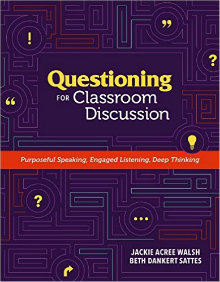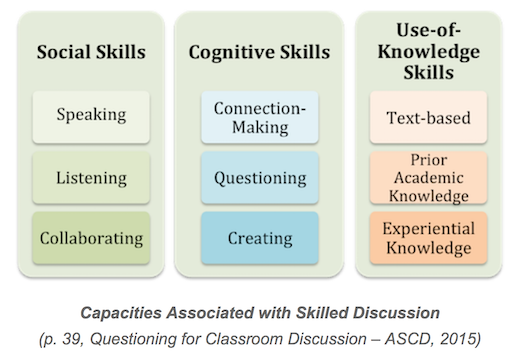How to Develop Deep Student Discussions
Questioning for Classroom Discussion: Purposeful Speaking, Engaged Listening, Deep Thinking
By Jackie A. Walsh and Beth D. Sattes
(ASCD, 2015 – Learn more)

After reading Questioning for Classroom Discussion: Purposeful Speaking, Engaged Listening, Deep Thinking by Jackie Acree Walsh and Beth Dankert Sattes, I immediately completed a mini action research project to put their suggestions to the test at my middle school. The results were very promising with the sample groups selected.

This book has everything you need. There are guides to prepare the teacher and students to engage in meaningful discussions. There are graphic organizers to guide you through the basics of preparing for, opening, sustaining, closing, and reflecting on the discussion.
The process not only focuses on the growth of the students but the growth of the teacher’s ability to ask questions that promote sustainable discussions.
Beyond hand raising
By using the strategies in the book, I found that when I constructed good questions and prepared the students for the “rules” of group discussion, I was pleasantly surprised at the results. The most challenging aspect of the small group discussion was “deprogramming” the students so that they stopped raising their hands and waiting to be called upon. I found that every academic level of student was engaged and had interesting things to say.
This book focuses on the need to elicit higher levels of thinking and not right and wrong answers. This approach is difficult for teachers; we need our students to perform well on high stakes test questions. Fortunately, with the adoption of the Common Core in many states, conversation and the art of discussion/debating are becoming more important components of learning.
Teachers need to be able to create quality questions that prompt discussion, teach discussion etiquette and techniques, and encourage student participation and engagement. Good answers will follow!
Equitable participation
One of my favorite parts of the book is the need for there to be equitable participation. The development of discussion norms is key to the success of these strategies. There are helpful suggestions to ensure that the students understand the guidelines for quality discussion on the part of the students as well as the teachers.
The book further discusses how several feedback and response solicitation techniques many of us incorporate, myself included, are counterproductive to open, nonjudgmental classroom discussions.
A structure to sustain deeper thinking
The book is well organized and easy to read. The opening chapter focuses on quality questioning. The authors emphasize why the teacher needs to frame the questions to initiate and sustain student thinking. There are guides for how to create good questions.

Chapter 3 delves into the social, cognitive, and use-of-knowledge skills. Chapters 4 & 5 provide the guidelines for whole group, small group, and student led discussions. Over the course of the book, Walsh and Sattes help their readers shift from teacher dominated classroom discussions to student led student conversations.
Graphic organizers, QR codes and more
There are graphic organizers included with prompts and key points as well as QR codes that provide excellent videos to demonstrate the strategies and techniques at various grade levels. Each chapter also provides opportunities for self-reflection or PLC discussions during the implementation process. The final chapter and appendices provide additional information to help teachers with the questioning process.
I will be using Questioning for Classroom Discussion to guide future PLC groups at the middle school level. I would recommend this publication for anyone who is serious about implementing meaningful questioning into their classroom routines.
Read a MiddleWeb article
by Jackie Walsh based on this book.
Sherry Drake has been in education for 23 years. She has been involved with instruction in regular and special education from kindergarten through grade twelve and instructional leadership at the elementary, middle, and high school levels in several states. She is currently involved with special education at the secondary level. She is working on her Educational Specialist Degree in Instructional Leadership.



































I teach Kindergarten and we are reading the book Questioning for Classroom Discussion: Purposeful Speaking, Engaged Listening, Deep Thinking by Jackie Acree Walsh and Beth Dankert Sattes. I am struggling with the developmental requirements for classroom discussions and questioning. Is there anyone using this book at this grade level? Is there a different book that may be more helpful?
Jacqueline, I oftentimes receive this question from K-1 teachers and have worked with primary teachers in a number of schools to address this challenge. As you suggest, there are important developmental considerations regarding classroom use of questioning and discussion–but it is important to begin this development as students begin their school experience. K-1 teachers tell me that they focus primarily on the “social skills” –speaking, listening, collaborating– and that they rely heavily on paired responses–such as Think-Pair-Share (TPS). They carefully structure this by designating and “A” partner an a “B” partner, and designating when each should speak. Having students stand up as they talk with a partner helps with management and monitoring issues. K-1 teachers with whom I have worked have experienced success in teaching their students about think time 1 and 2. They also scaffold this with physical signals (e.g., holding up hand or pointing to head during the think time.)
Very importantly, when teachers across a school are all working on teaching their students the skills of purposeful discussion, they can work to develop a continuum of skills that works for their students. I’ve found that different schools create different continuua, depending upon their context and their students’ characteristics. I encourage you and your colleagues to think about engaging in this activity.
I am not certain if I have adequately addressed your concerns, but I would be happy to continue the conversation if you email me at walshja@aol.com. I might also be able to put you in touch with a K or 1 teacher who is using this approach successfully.